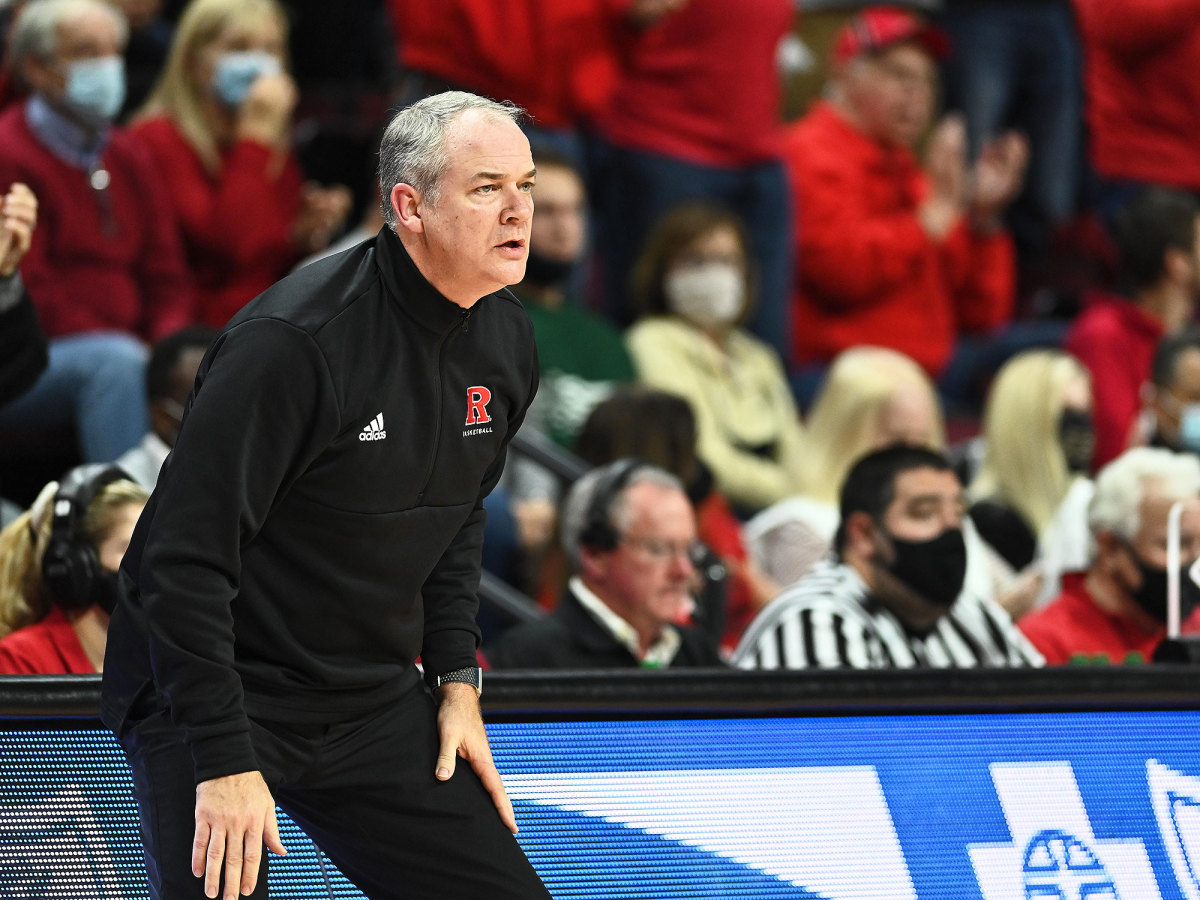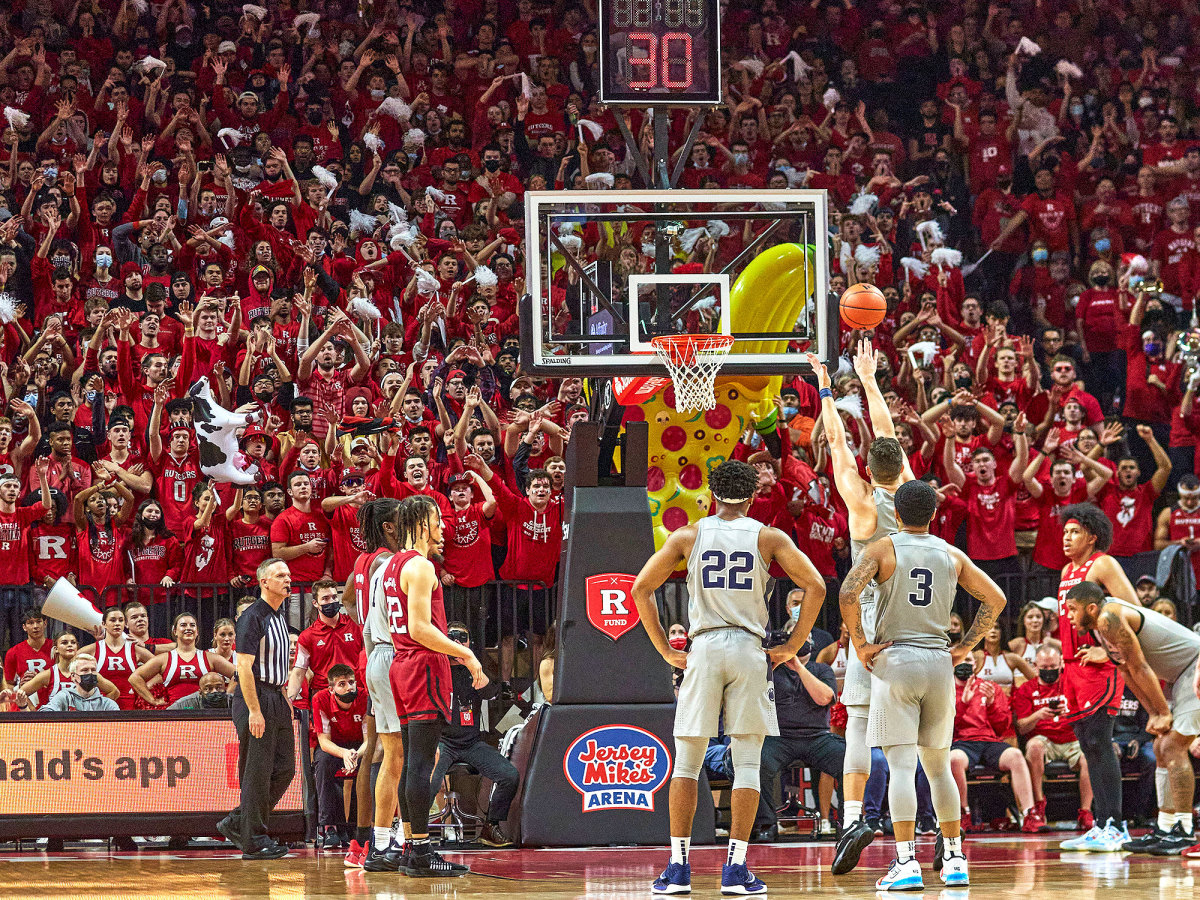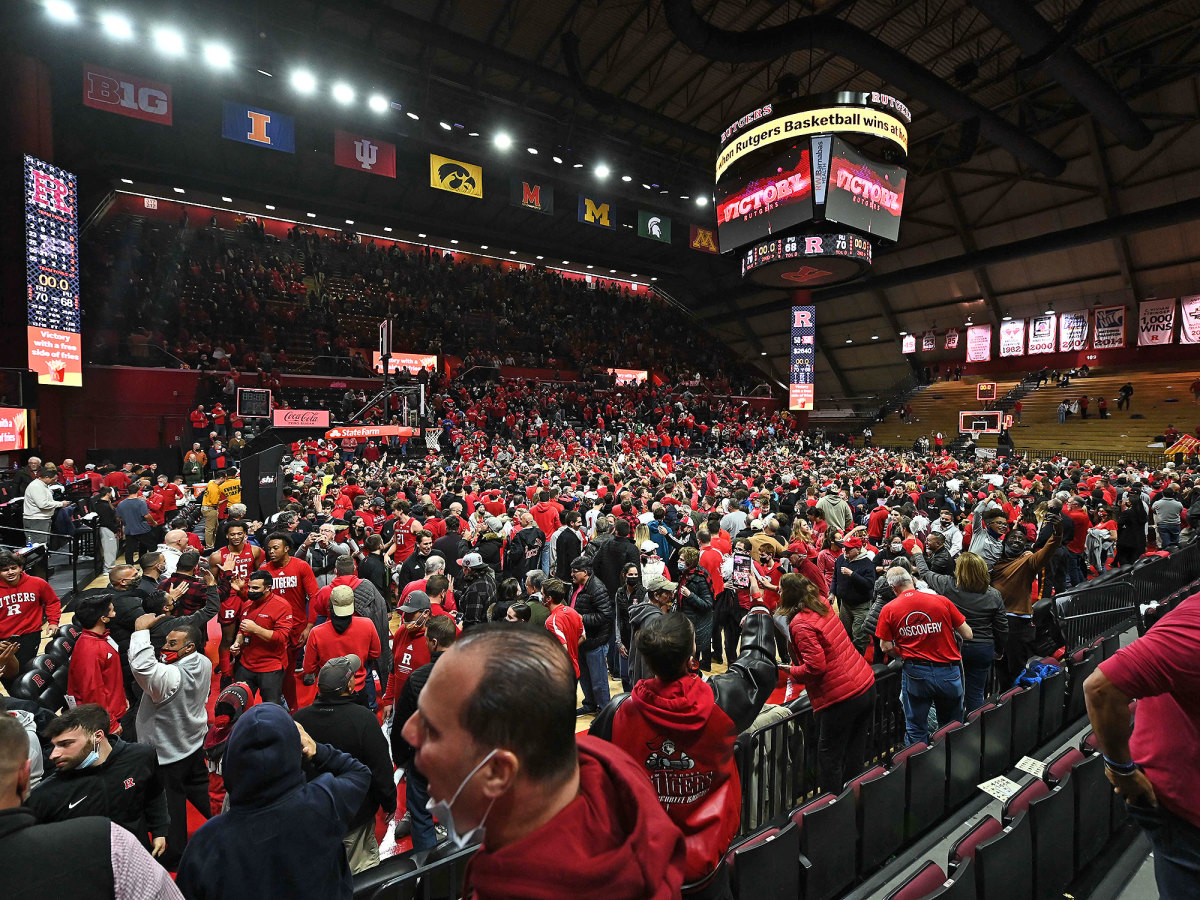How Rutgers Reemerged as Having One of College Basketball’s Greatest Venues
Steve Pikiell punched in Jim Calhoun’s number—his standard routine after receiving any job offer—and waited for a familiar New England inflection to bellow out from the other end.
Pikiell had just been pitched the coaching vacancy at Rutgers, a devastated program with little to offer besides a vision and administrative support. He sought the advice of his usual confidant and mentor of nearly 30 years.
Calhoun comes about as close as you can get to college basketball royalty. His CV includes three NCAA tournament championships, seven Big East titles and nearly 1,000 wins, naturally becoming an oft-tapped well of perspective for Pikiell, who played under Calhoun in the late 1980s.
The dynastic UConn boss was also famously reverent of Rutgers’s Jersey Mike’s Arena. Known then as the RAC, the name most Scarlet Knights fans still default to, he equated his experience playing there with the homophonous medieval torture device before a road tilt in 2004. So when Pikiell reached out to Calhoun about the Rutgers opening, men’s college basketball’s third-winningest coach didn’t mince words in describing the home court advantage Pikiell could build in Piscataway.
“Calhoun was the one guy who said, ‘[The RAC] is as tough of a place as I’ve ever had to coach,’” Pikiell says. “So, when you hear that from a guy who’s coached in every arena in the country and has won national championships, you really respect that statement.”

Pikiell ultimately took a gamble on Rutgers, which had finished its most recent season ranked 279th in KenPom, beginning as coach in March 2016. And as the Knights’ fortunes have changed over Pikiell’s tenure, Calhoun’s once laughable statement now reads like Nostradamus—Jersey Mike’s Arena might just be the toughest place to play in the nation.
Since November 2019, with full-capacity crowds, Rutgers men’s basketball has enjoyed a dominant 8–1 record against ranked opposition at Jersey Mike’s Arena and a 32–4 home mark overall, the fifth-best among Power 5 teams. Rutgers hasn’t enjoyed nearly the success of the four teams (Kansas, Baylor, Kentucky and Auburn) above it, narrowly sneaking into the NCAA tournament each of the last two seasons with a 6–21 record at road and neutral sites during the aforementioned stretch.
This remarkable home/road split substantiates the arena’s recently popularized “Trapezoid of Terror” moniker. It’s loud, it’s cramped—the 8,000-seat capacity filters out all but the most passionate Jerseyans—and it’s a terrifying place for opposing teams.
“[The fans] are just very involved, the acoustics in there are great, it’s loud and I don't think there’s a ticket left for the [2022–23] season,” Pikiell says. “I think it’s the toughest place in America for people to come and play.”
Jersey Mike’s Arena, which celebrates its 45th birthday this November, is an unglamorous architectural oddity. Even Rutgers’ fifth-year wing Caleb McConnell will tell you that.
“When I first walked [in], it was just weird,” McConnell recalls. “It looked like an older gym, not too impressive, and just not ideal for a big school.”
The front of JMA features an off-white, concrete facade often visibly in need of a power wash—arena architect Robert Hillier told NJ.com the design was probably more fitting for a warehouse along the infamous New Jersey Turnpike than a basketball facility. The two long sides of its trapezoidal exterior consist of thin, metal siding overhanging modest will-call booths and entry points, culminating in an unusual arena with a very Rutgers backstory.
Rutgers dreamed big in replacing its longtime home at College Avenue Gymnasium, famous for its showers of ceiling paint chips when the crowd reached a crescendo. However, tight pockets and campus politics saw the school abandon respective 13,000-seat and 11,000-seat proposals and slate just $8 million for Hillier’s design, forcing a creative workaround.
His solution—a trapezoid, designed to keep both supply and heating costs low.
Penny pinching paid off this time for Rutgers, usually left to rue the “RU Screw,” a local term used to describe the school’s legacy of blunders. Hillier designed steep, symmetrical seating along each sideline to fit within the trapezoidal shape, which, along with the small, steel-enforced interior, reflected the crowd noise back onto the court.
And, boy, does it get loud.

“It’s definitely an electric feel in there,” McConnell says. “The floor is always shaking. Sometimes it gets to the point where we can’t even hear each other on the court at all. The only thing we can do is just go off instinct.”
The legend of Jersey Mike’s Arena grows every time a decibel counter finds its way into the place, peaking at 115.3 decibels in February 2020, when Geo Baker led an 18-point comeback against Northwestern to preserve Rutgers’s perfect home record.
ESPN analyst Jon Crispin has compared the arena to Duke’s legendary Cameron Indoor Stadium, and Illinois coach Brad Underwood noted two years ago that “if you ask Big Ten coaches around the league, they’ll tell you [JMA] is the loudest.” The sustained noise has a knack for breaking down opponents.
“I really think the RAC gives us like, plus 6–8 points on offense and plus 6–8 points on defense,” Rutgers point guard Paul Mulcahy says. “I mean, we have a really great home court advantage.”
Most Rutgers fans of a certain generation will tell you the best game ever played at the RAC was a 1991 overtime win against UNLV—which had played in the Final Four the season before—followed closely by an A-10 championship victory over Penn State two years earlier.
“It was unbelievable,” longtime Rutgers fan Mike Kondrak says. “We were trailing by six or so with a minute left and we stole a couple inbounds passes to cut the lead. The crowd willed that game to overtime.”
That same year, 1991, also kicked off Rutgers’s 30-year NCAA tournament drought, one that eventually became the longest streak among men’s Power 5 programs and eroded fan interest. At first, the Scarlet Knights remained good for an annual shocker at the RAC—Carmelo Anthony’s national-champion Syracuse squad and Florida’s 2011–12 Elite Eight team stand out as marquee victims—and an ill-fated Big Dance push every few years.
“Even if the team was mediocre or bad, with the RAC it was magic,” says Kenny Kolanko, who served as Rutgers’ mascot, Sir Henry, in 2005–06. “There was kind of a supernatural thing going on in there. At the RAC it was expected that they were going to win every game.”
The primary source of inspiration for those early 2000s teams was Quincy Douby, Rutgers’s only first-round NBA draft pick since 1983, who enjoyed a beautiful, symbiotic relationship with the RAC. Douby’s trademark flair and avant-garde tendency to shoot from just about anywhere in New Jersey sent the RAC into delirium on a nightly basis, and the building’s energy was a key factor in Douby’s All–Big East season in 2006.
Like many great Knights, Douby drew his strength from the altar of prayer, which in his case was the RAC’s 92-by-50-foot center slab of hardwood. Whenever he needed a late-game boost, Douby would bend down and feel the RAC floor. The ground beneath him would rumble like an airport hangar, a pure manifestation of the building’s energy and passion for Rutgers. It inspired Douby to “do better and achieve more,” former Rutgers Court Club president Brian Kelley recalls.
But by the time the Big Ten came calling in 2014, the RAC was little more than an embarrassing eyesore, much like the Rutgers program. Having the conference’s smallest seating capacity—Indiana and Purdue fans are quick to mention that several Hoosier State high school arenas also outsize Rutgers—was made worse by half-empty crowds, unkempt concourses and play on the court that amounted to just three wins and 14 20-point losses through two seasons of Big Ten play.
“There wasn’t a lot of hope in the building; it really was dark,” says Kelley. “This was like, ‘Oh man, who is going to come in here and coach this team? Is there a light at the end of the tunnel?’”
Pikiell ultimately became that prophetic coach, quickly employing a piecemeal plan to return the RAC to its former glory.
Step one: air conditioning, recalls Pikiell—an imperative for a coach who spends most game days in formal attire shuffling across the floor in a defensive stance, his archetypal, gym-rat recruits looking to complete a summer workout without needing an IV, and a disillusioned fan base looking for any excuse to stay away.
Once AC arrived at the RAC in May 2016, refitting the program’s aging facilities became the next objective.
“We had our antiquated weight room in the building and we got that redone,” Pikiell recalls. “We had a locker room that needed a lot of TLC; we renovated that completely. We went about improving some of the areas that had to be improved.”
Rutgers also unveiled a state-of-the-art performance center in 2019, home to Pikiell’s new office (with windows this time) and a 135,000-square-foot practice facility he considers among the best in the country. The final step was luring the fans back in—the longest and most imprecise leg of the revival.
Stories of the RAC’s former glory had become fables in the Rutgers community, almost unverifiable against decades-old audio recordings and featuring a caliber of atmosphere thought impossible to return to during the program’s numerous dark years. The aforementioned Penn State and UNLV games, lauded as the arena’s crowning moments, were played before hundreds of thousands of current Rutgers alumni could walk upright.
“We didn’t have a record of tradition in the last 20 years,” Pikiell says. “We didn’t really have the student fan base. So we did a lot of things with the fraternities and the sororities, the RIOT Squad and players got out in the community so people would embrace them and know what kind of great kids they are.”
Still, there’s no bigger draw than winning basketball, and the high-profile games early in Pikiell’s tenure always seemed to end in demoralizing duds. Energy from a 2–0 start in 2018 quickly evaporated after a 19-point home loss to St. Johns, and backbreaking losses included Joe Wieskamp’s impossible, game-winning bank shot for Iowa from the corner later that season.
It was a mid-December matchup against Seton Hall in December 2020 that finally and truly reintroduced a new generation of Rutgers fans to their home arena, as a sold-out crowd saw the Knights surge to a 20–3 lead against the No. 22 Pirates and ultimately cruise to a dominant 68–48 victory. Rutgers would sell out 23 of its next 28 home games, including a 12-game streak that stretched across more than 22 months, and would win its next nine home contests.
Tickets, which Pikiell recalls not being able to give away at the beginning of his tenure, now start at over $100 on the secondary market for Rutgers’s most marquee matchups. Students in recent years have been seen forming lines outside the stadium as early as 4:30 in the morning.
“When I first took the job, I learned it’s a tough league traveling to all these arenas,” Pikiell says. “You got to play at Purdue and Indiana and Michigan State; these places have huge homecourt advantages. And now we have the same advantage.”
If you ask Kelley to list the best things about the RAC, you’ll quickly get an answer evidenced by years of losing and horrid basketball.
“That’s what’s good about the RAC. It shows up when there’s no reason for it to show up.”
And while a stout 2019–20 season revived hope in the building, a calamitous start to the ’21–22 campaign gave the RAC every reason to give up on its Scarlet Knights. Losses to Big East bottom-feeder DePaul, Lafayette (which finished among the nation’s 40 worst teams) and UMass contributed to Rutgers being given less than a 1% chance by February of earning an NCAA tournament at-large bid, per T-Rank. It faced a slate of four straight must-win games against ranked foes—no unranked team had ever come out of such an onslaught with four W’s.
The odds were impossible; there was no reason for the RAC to show up. Yet it did.

“Every one of those games were just so electric,” McConnell says. “It’s definitely always loud and always crazy, but when we went on that streak and beat like four ranked teams in a row, we couldn’t hear anything.”
During a win over Michigan State, FS1 analyst Donny Marshall compared the atmosphere to “a Subway coming down the tracks.” Against Ohio State, as the RAC’s usual shaking turned seismic and the crowd reached a piercing apex to force a hapless Buckeyes shot-clock violation, Mulcahy looked up in appreciation and could think only, Man, this can’t be safe. And with Illinois in town, a blacked-out RAC crowd helped induce five straight missed free throws by the Illini en route to a dominant victory.
It took only 11 days for the arena’s magic to help transform Rutgers’s season, from hopeless disappointment to one of the most memorable ones in program history. The Knights rose 37 places in the KenPom rankings and ended up, unthinkably, back in the NCAA tournament.
Within the largest budget in New Jersey history passed in June was a rare windfall for Rutgers. The historically underfunded and indebted athletic department received $100 million earmarked for renovating Jersey Mike’s Arena, which had hardly been touched in its 45-year history.
Initial goals of renovated bathrooms and modernized concessions achieved near-universal support among Rutgers fans, but anxiety spread once the time line began to leak. Early reporting suggests that prolonged RAC renovations may force the Scarlet Knights to find an alternative venue for the 2023–24 season.
Rutgers fans turned into amateur acoustics experts, scrutinizing the amount of ceiling tin needed in rumored stadium renderings and debating whether the anticipated luxury boxes would compromise the stadium’s identity.
“I worry about them, for sure,” Kelley says of the proposed renovations. “I know there are 13 other Big Ten coaches right now that are hoping they make the RAC into a luxurious, palatial kind of place because they don’t want the edge that it provides for Rutgers anymore.”
To the relief of most of the Scarlet Knights faithful, Pikiell and the program seem to see past most of the bells and whistles possible in a nine-figure renovation, embracing the grungy, unsexy, Rutgers-y arena Calhoun described years ago.
“What I would like is to keep the RAC, you know, the same,” Pikiell says. “The same acoustics, the same environment, just update it a bit.”
More College Basketball Coverage:
• SI’s Big Ten Preview, Preseason Rankings
• Ten Coaches on the Rise Entering 2022–23
• Men’s Preseason Player of the Year Candidates
